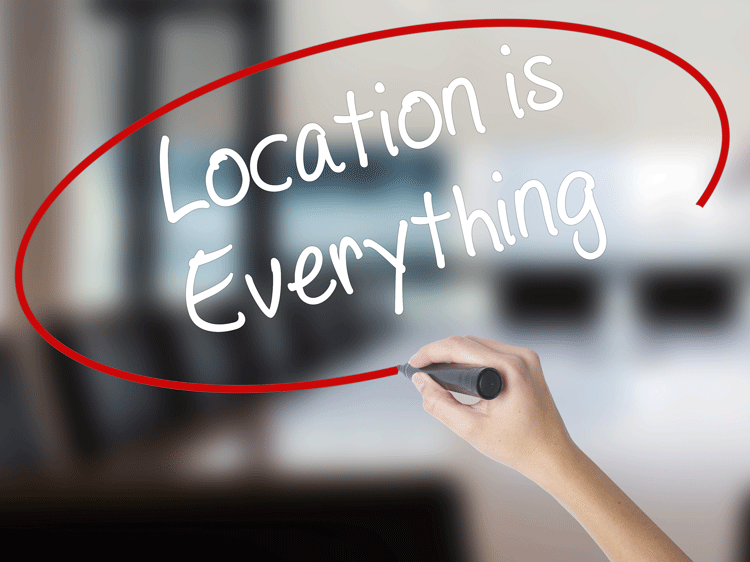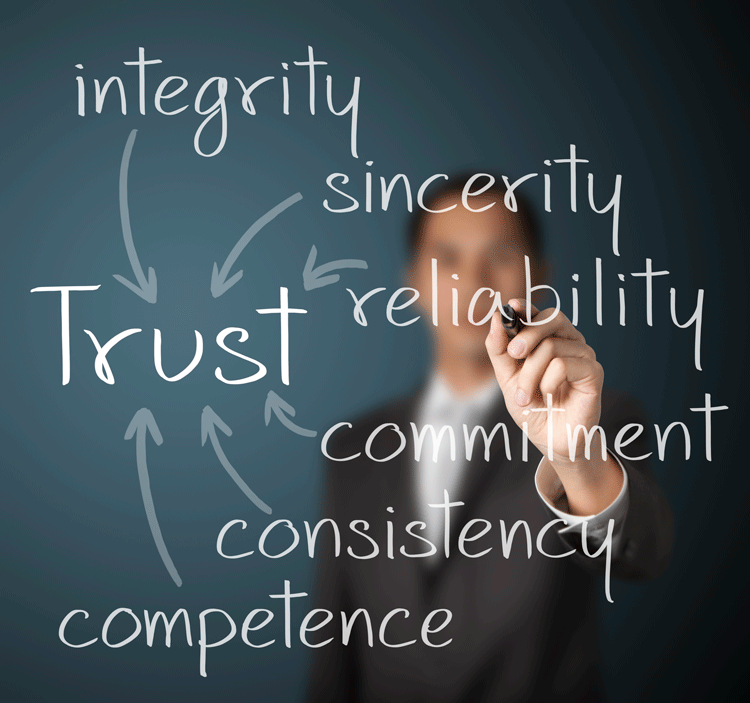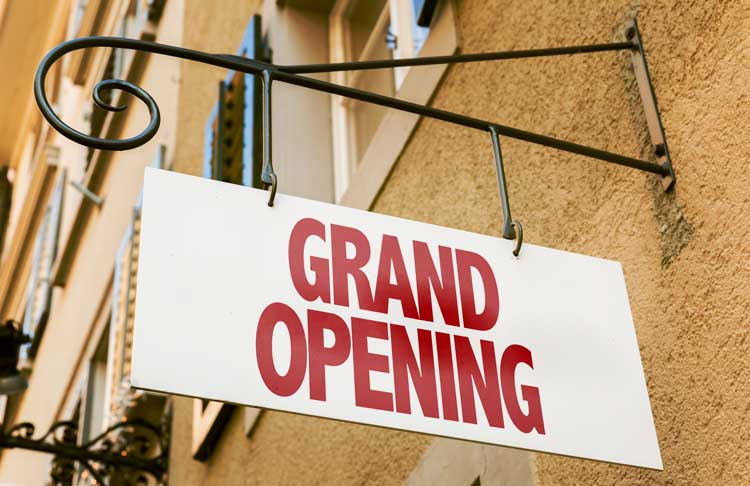Category: Retail Development
Make The Most of Future Retail Development With These Tips For Strategic Site Selection
Posted by Retail Attractions Blog on May 15, 2019 in Blog | No Comments
If you want to make the most of future retail development, then it’s time to for a more strategic approach to site selection.
It used to be that most companies approached site selection as a tactical activity rather than a strategic one. No matter how many new locations you were planning on opening, there’s a good chance you treated each site selection individually. The goals for this type of process are often concrete and focused on specific locations rather than on how each site relates to a larger plan.
Strategic site selection, on the other hand, takes a more holistic view of things. With this approach, you’ll be thinking about your company’s long-term goals. You’ll also focus on figuring out how each selected site relates to those goals.

Think Long-Term
For strategic site selection, you’re going to want to take into consideration more than just how each site will work for your company today. You’ll also want to consider how site selection relates to your entire network of locations. In addition, you’ll need to consider future plans for expanding your network as well as the current state of your business ventures.
Of course, this means extra work on your part. But taking the time to research, plan, and strategize in addition to the other steps you take during the retail site selection process is going to pay off in the long-term.
Remember The Basics
As you’re developing your strategic, long-term site selection plan make sure you don’t overlook the basics of site selection. Choosing the right location for new retail expansion is key to success. You don’t want to overlook important factors about choosing individual sites because overall goals distracted you.
Strategic site selection starts with narrowing-down which cities and towns fit best with your long-term goals for building a network of locations. Once you do that, it’s time to zoom-in and choose the best site to build. For further information about this vital step, check out our articles on the most important factors in retail site selection:
- The Most Important Factors In Retail Site Selection: Part One
- The Most Important Factors In Retail Site Selection: Part Two
Evaluate Ongoing Performance
Part of strategic site selection is continuing to evaluate your site after selection. A location that used to work really well might not be ideal 10 or 20 years from when you first selected it. As you continue to track data on each location, you can adapt your strategy to include evaluating existing locations. Some under-performing locations might just need additional investment to reach their full potential. For others, the strategic decision might be shutting that location down and investing resources elsewhere.
If you want help with making your retail site selection more strategic, get in touch with us. We have extensive experience helping retailers find the best possible locations for their next expansion. Also, be sure to pick up a copy of my books. City On A Hill is a book about cities and how to make them better, and my new book The Devil’s In the Details addresses things that challenge city government and the language of development.
How To Identify And Act On Retail Opportunity Gaps In Your City
Posted by Retail Attractions Blog on March 28, 2019 in Blog | No Comments
If you’re looking to bring new retailers into your city, it’s important to know what type of demand there is among your population. One way to find out where the retail in your community isn’t meeting the demand is by using a retail opportunity gap analysis.
When you know what people are leaving your community to buy it empowers you to take steps toward stopping retail leakage. With a reliable gap analysis to work from, you can begin an educated retail recruitment campaign to bring in the appropriate retailers and stop the revenue bleed.

What Is A Retail Gap?
When people living in your city’s retail area leave to shop elsewhere, it indicates your population has a demand that’s not met by the current supply in your community. This gap between demand and supply is what we mean when we talk about a retail opportunity gap. We also call this “retail leakage.”
This gap represents the potential to fill a demand by bringing new retail into your community. When you have a reliable opportunity gap analysis to work from, then you have a starting point for targeting retailers that fill the sales gaps in your marketplace
How Do You Find Gaps?
Getting a gap analysis is pretty easy. There are even online tools that will do it for free. However, those sorts of tools are extremely basic. They also don’t take into account all the variables needed to generate a reliable analysis of retail leakage/opportunity gaps.
The first step toward a reliable gap analysis is to accurately define your trade area. Then you’ll need to identify where the customer base within the trade area is spending their money. Those who are shopping outside of your trade area represent retail leakage. For these steps, it’s a good idea to hire a retail expert who will ensure the reports are accurate and useful.
How Can I Get Accurate Reports?
Estimating trade areas requires skilled judgment and experience. Concentric rings or drive times reports are too simple a method to provide more than basic information. That’s why Retail Attractions takes into account factors such as population densities, retail voids, competitive communities or retailers, natural barriers, traffic flow, accessibility, and convenience. This lets us define an accurate primary trade area.
Once we’ve defined the trade area, it’s time for an Opportunity Gap Analysis. This analysis provides an actionable portrait of sales opportunities, allowing you to maximize your growth strategies. We generate an opportunity gap analysis by using sales potential to depict supply and geography-based estimates of potential annual consumer expenditures to depict demand. Then, we’ll use our expertise and connections to help bring in retailers who can best fill the gaps in your community’s retail landscape. Just contact us today to get started.
If you found this article useful, then you’ll probably also like my books. Click on the titles below to learn more and order a copy.
The Most Important Factors In Retail Site Selection: Part Two
Posted by Retail Attractions Blog on December 19, 2018 in Blog | No Comments
There are several important factors to consider when you’re making decisions about retail site selection. Choosing the right location for new retail expansion is key to success. Location, location, location…As such, it’s vital that you understand all the factors involved.
The better you understand these important factors, the more likely you are to have a successful development site. We talked about five key factors in Part One that will help you narrow-down which cities and towns can be good fits for your business. Today in Part Two we’ll talk about five more factors that can help you choose the best site to build.

Co-Tenant Quality
It’s vital that you consider the existing tenants surrounding a potential location for retail expansion. The neighboring businesses often have a profound effect on your success. You want to locate where surrounding tenants are drawing consumers already. The quality of the real estate around the site should be compatible with the use as well. Buildings with a lot of swag and national brands probably wouldn’t be a good co-tenant with a vape shop or a tattoo parlor.
Proximity to Competitors
Some would think that locating too close or adjacent to a competitor would not work. But it wouldn’t take you long to disprove that miss-conception. I was doing work for a national QSR looking at sites in an urban area and lo and behold every site they wanted to see already had a McDonalds near or on the opposing corner. This really excited the franchisee as he wanted to be as close the big boys as possible.
Traffic Counts
Getting information on traffic counts for any given location is pretty easy. Just make sure the counts you get are current. Every retailer wants the same thing, accessibility and visibility. The object is the more traffic the better, but consider access, and turning movements and ease of exiting your location back to the main traffic corridor. Lots of cities are designing boulevard style streets with medians and landscaping. Right in and right out only turning movements are a requirement in lots of urban and suburban settings. Just make sure the due diligence is done and all the issues are planned through.
Parking Availability
Customers don’t like having to park off site or pay for parking. If you build in a location without good parking, there’s a good chance some customers will decide your business isn’t worth the extra hassle. A well-maintained, convenient, and free parking area is a definite asset when you’re selecting a retail site. Most modern building codes require a certain number of parking spots per square foot of the building anyway. Mutual access and mutual parking agreements are also common. Study the essentials and avoid disappointment.
Finances
The last, but certainly not least, factor we’ll talk about is the economics of your retail site selection. When considering finances, take a look at the value each property you’re considering can offer. The price you’re paying to build, purchase or rent space definitely plays a role. You’ll also want to consider utilities costs and amount of maintenance you’ll be responsible for. If you want to be next to the big boys be prepared to pay.
……………………………………………………………………………………………………………………………………..
If you liked this article on important factors in retail site selection, be sure to check out the other articles on RetailAttractions.com. And if you want any help with retail site selection, get in touch with us. We have extensive experience with helping retailers find the best possible locations for their next expansion.
Also, be sure to pick up a copy of my new book The Devil’s In the Details: Things that Challenge City Government and the Language of Development. It addresses glaring problems and issues that destroy foundational economic development efforts for cities and provides guidelines for how to overcome those issues. Click here to order.
The Most Important Factors In Retail Site Selection: Part One
Posted by Retail Attractions Blog on December 13, 2018 in Blog | No Comments
When you’re making decisions about retail site selection, there are several important factors to consider. Selecting the right location for new retail expansion is key to success. As such, it’s vital that you understand all the factors involved.
The better you understand these important factors, the more likely you are to make a good site selection. We’ll talk about five key factors in this blog post, and five more in Part Two.

Customer Demographics
To look at relevant customer demographics in a certain area you need to know what type of customers will frequent your business. In other words, What is your target demographic’s customer profile? Knowing this will let you determine whether or not the customer base in the area you’re looking at is large enough to support your business.
Once you know what your customer profile looks like you can take this factor into account in retail site selection. Take a look at median household income, average age, marital status, family size, education level, etc. in the location you’re considering. The better a location’s population matches your target demographics, the better this site will be for your business.
Customer Psychographics
Demographics are about who your buyer is. Psychographics tell you why they buy. It takes into account “your buyer’s habits, hobbies, spending habits and values” (from “How to Use Psychographics in Your Marketing: A Beginner’s Guide”).
Once you understand more about why your customers buy your products, you can make sure that you’re selecting a location that will appeal to them. For example, if most of your customers are health-conscious they’re more likely to find your store if you build near a gym than near fast-food restaurants.
Trade Area Population
You also need to look at how many people live in the area you’re considering for your next retail site. There has to be a large enough population in your trade area to support your business or there’s no point in building. You’ll also need to make sure that a high enough percentage of this population fits your customer demographic.
There’s more to defining an accurate trade area than just using concentric rings. You need to take into account population density, competing communities, natural barriers, traffic flow, accessibility, and other real-world factors.
Location Quality
If the trade area population matches your customer demographics and psychographics, then it’s time to start considering specific locations. You’ll want to look at how far each location is from residential areas and how visible it is from the road. Also, consider whether or not nearby businesses will draw-in customers who fit your profile.
You’ll also want to consider whether or not you’re going to plan for multi-location growth. If the trade area can only support one store or restaurant, then you’ll want a central location. But if the community, and your customer base, is growing you’ll want to plan ahead for the possibility of opening other locations in the future.
Location Access
People are far more likely to visit your business if it’s easy to get to. You want people who see your sign or look you up online to be able to find your business easily If it’s too hard to access, then there’s a good chance potential customers will give up on finding you.
An ideal location makes it easy to turn in from the nearby roads and get into the parking lot. It should also be easy to get out of the parking lot, and if there isn’t a traffic signal in place you’ll want to find out whether the community is willing to put one in.
If you liked this article on important factors in retail site selection, be sure to check out the other articles on RetailAttractions.com. And if you want any help with retail site selection, get in touch with us. We have extensive experience with helping retailers find the best possible locations for their next expansion.
Also, be sure to pick up a copy of my new book The Devil’s In the Details: Things that Challenge City Government and the Language of Development. It addresses glaring problems and issues that destroy foundational economic development efforts for cities and provides guidelines for how to overcome those issues. Click here to order.
5 Key Steps In The Retail Site Selection Process
Posted by Retail Attractions Blog on November 7, 2018 in Blog | No Comments
Selecting the right location to build is crucial when planning for retail expansion. The site selection process will be among the most important decisions you make, which means taking time to do things the right way is going to pay off big in the long run. Here are five key steps that will help you make the best retail site selection.

1) Analyze Data
It’s vitally important that you base your site selection on facts. To get those facts, you’ll have to analyze data related to customer demographics, trade areas, market needs, and other factors. When you’re doing this, keep in mind that concentric rings or drive times aren’t the best factors for determining who’s in your trade area. You’ll get much better data using a method that’s based on Reilly’s Law of Retail Gravitation. This is also what Retail Attractions uses.
2) Factor In Surrounding Retail
It’s not enough to know the data about customers in your trade area. You also have to consider other factors. For example, other businesses surrounding the location you’re considering can impact the kind of traffic that’s coming in. You want to be able to profit off cross-shopping traffic from neighboring retailers. You’ll also want to avoid markets that are already saturated with direct competitors.
3) Identify Optimal Sites
After figuring out which communities have a good trade area and aren’t saturated with competing retail, you can start to narrow your focus. Find out if the available sites can actually meet all your needs. Figure out traffic patterns and determine how easy it will be for customers to notice, find, and get to each location. Check out local regulations and site economics to find out if this is a profitable place to build.
4) Find A Retail-Friendly Community
Most communities would welcome an influx of retail, but the number that’s actually ready to work with retailers is much lower. Try to find a community that provides retail incentives and has the municipal infrastructure in place to support retail growth. Time-to-market (the time between acquiring a property and opening the store) directly impacts your bottom line. If a community can streamline compliance regulation and show that their transportation, water, sewage, and electrical infrastructure can handle new growth, they can easily jump to the top of your consideration list.
5) Get An Expert’s Advice
There’s a huge number of factors, including several we haven’t talked about in this post, that play a role in retail site selection. A retail expert can help keep track of all these factors, make sense of data, and ask the right questions during the site selection process. Click here to learn more about how Retail Attractions can help with site selection. If you have any questions or want to find the perfect retail site, just contact us. We hope to hear from you soon!
Don’t Make These 5 Common Mistakes In Retail Site Selection
Posted by Retail Attractions Blog on October 2, 2018 in Blog | No Comments
It would be an understatement to say that retail site selection isn’t easy. There are so many things to consider when deciding where to build, and it’s easy to make mistakes.
While these mistakes can be critical, they’re also something that you can avoid. Keep reading to learn how NOT to make these five common mistakes in retail site selection.

1) Relying On Limited Models
Site selection models are a great starting point. But they’re not the only thing you should base decisions on. Make sure you’re also looking at variables which can’t be easily measured (such as visibility ratings) and consulting with retail experts who can help provide context for additional data.
2) Unbalanced Customer Profiles
It’s important to look closely at the overall population in your retail area, as well as the percentage of that population which fits your target customers profile. How much weight you put on each number will, in part, depend on where you’re building. For example, an area with low population density can still support new retail if a high percentage of people there fit your target profile. In areas with large populations, you might still find success even if there’s a relatively small number of your target customers.
3) Not Adapting To Customer Needs
The companies that continue to build new stores even during the “retail apocalypse” are typically the one responding to customer needs. It’s time to stop thinking of retail expansion as building more or larger stores and start zeroing in on what customers want. In many cases, small footprint stores are the best way to fill customers’ needs.
Further reading: New Retail Growth Is Still Happening In Spite Of The “Retailpocalypse”
4) Poor Decision-Making Structure
In order to make an objective decision about site selection, it’s important to make sure no one person has too much control. There’s a danger that a single decision maker, or even a small group, might have too much invested in a specific location and lose objectivity. Make sure there’s a decision-making structure in place that takes the entire group’s interests into consideration.
5) Not Hiring An Expert
With all the variables that go into retail site selection, it’s difficult to take everything into account without outside help. Hiring a third-party consultant like Retail Attractions gives you a big advantage. Our Demographic Analysis and Opportunity Gap Analysis supply nuanced information that will let you know if your company can fill retail gaps in the communities you’re looking at. We can also offer counsel on the best way to expand, and act as an objective voice in decision-making. Get in touch with us today to get started.
If you found this article useful, then you’ll probably also like my book City on a Hill. It gives a no-nonsense take on economic development that’s really helpful for companies looking to expand their retail development.
Building Trust As A Core Value Is Key To Healthy Public/Private Partnerships
Posted by Retail Attractions Blog on September 5, 2018 in Blog | No Comments
A public/private partnership might be just what your city needs to catalyze economic development and growth. These partnerships offer a win-win situation for both parties. The public party gets funding for public infrastructure and retail growth, while the private party gets incentives that let them expand into a new market. If everything goes as planned, both parties get substantial benefits from the arrangement.
When you’re involved in setting up a public/private partnership, building trust between the two parties is essential. Without trust as a core value it will be very difficult to work together and achieve the goals of your partnership. Here are a few tips for building a foundation of trust that will make your partnership work.

Honest Communication
Opening up communication channels between the public and private partners is a key first-step toward trust. Good communication in the early stages of negotiation lays the groundwork for a successful partnership. Also, having good communication habits in place will help keep the partnership on-track in the future.
Don’t hide things from your partner. Problems shared early on can be handled together, building trust in the partner’s ability to be honest and work-through difficulties. Communication between the partners should also include discussing goals, exchanging ideas, and finding common ground.
Follow-Through On Commitments
Parties start building trust in each other’s interests, qualifications, and diligence early in the selection process. Finding an appropriate partner can be a challenge. Each side will be giving the other partner a chance to demonstrate their qualifications and commitment and then seeing whether or not they follow through with what they promise.
No one is going to trust a potential partner if they don’t follow-through on their commitments. Once the partners clearly communicate what they expect from the other, both have to live up to those expectations. That includes showing up on time for scheduled meetings, completing agreed upon tasks, and continuing to work toward mutual success.
Cultivate Understanding
Communication and commitment stay vital to the success of the partnership after papers are signed and development starts. As you continue building connection between partners, you should be developing a relationship based on trust as well as shared goals. Both parties need to agree upon performance measurements and hold themselves accountable to those measurements.
Each partner needs to act honestly and in good faith as the partnership continues. And they should be able to trust that the other party is doing the same. It’s vital that both sides continue working to understand the other’s goals and perspectives.
Don’t Forget Stakeholders
Building trust in a public/private partnership isn’t just about the relationship between the two partners. You also want other stakeholders and the public to trust the partnership has their best interests as a core goal. To do this, you’ll need a high degree of transparency and a commitment to present realistic expectations. Exaggerating or misrepresenting the project’s goals might increase support at first,but it will back-fire. Be sure you can follow-through on promised goals.
Whether you’re just getting started looking for a public/private partnership or you’re ready to set one up, Retail Attractions can help. We have years of experience working with both public and private partners and we have the skills needed to help your partnership become a successful one. Contact us today to learn more about how we can help. If you need work with public-private partnerships, you’ll probably also like my book, City on a Hill. Click here to get a copy.
New Retail Growth Is Still Happening In Spite Of The “Retailpocalypse”
Posted by Retail Attractions Blog on August 21, 2018 in Blog | No Comments
We’ve all been hearing about retail closings that are sweeping our nation. It’s a “retail apocalypse” with record-breaking closings in 2017 and 2018 on track to set a new record. But the news isn’t all bad. There are still certain retail categories that are growing and several brands are opening new stores. Here’s a look at the type of retail development that’s continuing to thrive in spite of the retailpocalypse.

Small-Format Stores
With so many customers shopping online now, quite a few retailers are switching to small-format brick-and-mortar stores. These stores support the online shopping experience and give customers a chance to check out the products in-person. They act as a hub for in-store pickup, easy returns, and local delivery. Target, one of the few retailers actually expanding in 2018, expects to open 35 of these small-format stores this year.
Discount Sector
Off-price stores continued to expand even during the record-breaking closings of last year. Discount brands like T.J. Maxx, Marshall’s and HomeGoods are thriving. Dollar General and other dollar store are expanding all across the US. And deep-discount stores like Ollie’s Bargain Outlet are also opening new stores. These aren’t just small-format stores either. They’re moving into large retail spaces that are new or newly vacant.
High-End Retail
At the other end of the spectrum, the high-end retail sector is also growing. Brands that started off online like Birchbox, Bonobos, Brilliant Earth, and Warby Parker are starting to open brick-and-mortar stores for the first time. The information gathered from their online customers lets them target retail expansion to locations where they already have a customer base. The ability to zero in on their best markets makes expansion a less-risky prospect for these retailers.
Grocery
Even though more and more websites offer online shopping for groceries, these sites still can’t beat a grocery store for convenience. People want to inspect their produce before they purchase it and they want to make sure their perishable items don’t spoil in shipping. They might buy some items online, but brick-and-mortar grocery stores aren’t going away any time soon.
Restaurants
Another category that will continue growing is restaurants. In fact, restaurants are so popular that they can anchor other forms of retail. Some former shopping centers in Seattle, New York, and Denver are finding success with food-themed malls. Restaurants and specialty groceries act as the main draw to these shopping centers, attracting customers to other types of retail as well.
Whether you’re a community hoping to attract new retail growth or a retailer looking for the best place to expand, Retail Attractions can help. We have extensive experience working with developers and cities to create the best possible outcome for all interested parties. Contact us today to learn more.
Things To Consider When Negotiating a Fair Deal Structure in Public-Private Partnerships
Posted by Retail Attractions Blog on July 30, 2018 in Blog | No Comments
Whenever you’re negotiating a contract, you want to get a fair deal. And so does the group you’re negotiating with. “Fairness” is a subjective term, though. It’s going to mean something different to different people. If you want to negotiate a fair deal structure for a public/private retail development partnership, it’s going to take some extra effort.
So how do you go about making sure that all parties are reasonably satisfied? Keep reading to find out.

A Fair Deal
Each party in a public/private partnership is invested in the outcome of the deal and has a stake in upholding the transaction documents. In a fair deal, they’ll be reasonably certain of achieving the outcomes both agreed on. Both sides accept the risks as well as the rewards and acknowledge there’s a fair balance between the two.
The public and private side each contribute to making sure the deal stays fair. The private side takes financial risks expecting to reap significant rewards on that investment. The public side balances that investment by providing infrastructure, incentives, and other resources. And they’re expecting to receive a return on the investment as well in the form of employment opportunities, an improved sales tax base, available services, and other public benefits.
A Foundation For Fairness
It’s pretty much inevitable that a public/private partnership will hit a few rough patches during the course of your retail development deal. You can make things easier down the road by laying a foundation early-on that supports your goal of maintaining a fair deal structure. Both parties need to do their homework and evaluate the risks and returns offered on both sides.
Don’t just leave negotiations up to the lawyers. The more involved each side is during the negotiation, the better you’ll be able to ensure you’re creating a fair deal. Open communication and shared information go a long way toward cultivating the mutual trust needed to maintain a fair partnership.
A Need For Counsel
While it’s vital that both parties stay involved when negotiating the deal, they can also benefit from an outside perspective. Public/private partnerships involve a wide variety of technical and legal details. So you’ll want to hire someone with the expertise to make sure everything goes smoothly. It’s better to take a little extra time and bring in an expert than to rush into a deal only to find out later that it wasn’t as fair as you both thought.
Retail Attractions provides a much-needed perspective on partnership negotiation. We have extensive experience with retail development details. We’ll help you make sure the deal you work-out benefits both parties. With our knowledge of the retail development process, we can advise both public and private parties as they negotiate and compromise to develop the best possible contract. To learn more, contact us and check out the book City On A Hill.
Early and Frequent Communication Is Key To Developing Public/Private Partnerships
Posted by Retail Attractions Blog on June 27, 2018 in Blog | No Comments
If you’re going to get a public-private partnership off to a good start, communication is essential. The more you can open up and use communication channels between each partner the more successful your partnership will be. Good communication lays the groundwork for a successful partnership, and building effective communication habits will also help keep the partnership on-track in the future.

Communication Between Partners
Public-private partnerships are complex things which often involve large groups of people. Without a plan for achieving effective communication within this partnership, the partnership can crumble. Because of this, communication is key to getting both parties working as a team.
Internal communications should include shared partnership objectives. Partners should discuss their goals and find common ground that will help them develop and agree on ways to reach those goals. Good communication allows the exchange of ideas, information, and needs that is required to support effective decision making within the partnership.
Communication Outside The Partnership
Both public and private partners should also prepare for communicating about the partnership to those outside it. Good communication within the partnership is an essential first-step for this. You don’t want different parties disagreeing with each other publicly. Make sure you’re keeping all spokespersons for the partnership up-to-date on what’s going on so they can deliver a consistent message.
External communication with stakeholders, investors, public officials, the local community, and the media isn’t something you can afford to overlook. When your partnership cultivates a transparent, honest approach through community outreach and communication, you’re taking a big step toward ensuring continued support for the project. Just don’t make the mistake of over-communicating. For example, if you announce a plan to purchase land before the deal is finalized it could drive-up land prices in that area.
Get Help With Your Communications
Because good communication is so important to the success of public-private partnerships, it’s not something you want to leave to chance. A trusted third-party consultant like Retail Attractions can help. We have extensive experience working with both public and private parties. And we know how to foster good communication within a public-private partnership.
A Retail Consultant helps you navigate the confusing world of retail development effectively. We can help with strategic planning, site selection, demographics analysis, and so much more. And since we’ll be sharing the same information with both the public and private partner, that’ll help with communication.
If you need to work with public-private partnerships, you’ll probably like my book, City on a Hill. It’s full of helpful information for everyone working on retail development in a community.
